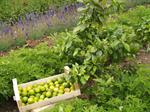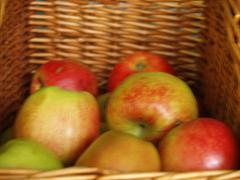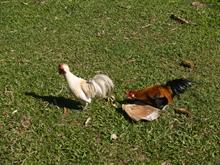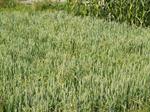
Produce and Better Manage Your Food Needs
- Spend less -supplement your needs with production from even a small home garden; or
- Become a Permaculture Designer/Consultant.
- Learn to be self sufficient with your food. You learn about nutrition and how to balance your diet, as well as how to produce, process, store, and use different types of food.
ACS Student comment - Anne Gilleade, Australia, Self-sufficiency 2 course:
"[My tutor] responds positively to my assignments and various design ideas and has a clear understanding of the topics covered that enables her to expand on those ideas. I have enjoyed this course more than most study I have encountered. The content and the notes for that content have been a good guide for the development of our property and what we produce and manage on that property.
I find the course to be a very valuable learning experience for the following reasons:
- The notes for the topics are written in plain English and cover all the scientific aspects simply and thoroughly.
- The distance mode allows me to study at my own pace-I work full-time in a demanding job and this study method allows me to complete the assignments even though I cannot complete them as quickly as I would like.
- The assignments give me the basic notes with the opportunity to research the topics in my own way - this has allowed me to build on my knowledge through the course."
COURSE STRUCTURE
This course deals with food; what to eat, how to produce it, how to store it; and how to prepare it. There are ten lessons in this course, each requiring about 10 hours work.
The content of each of the lessons is outlined below:‑
- Diet and Nutrition
- Introduction to good health
- Science of nutrition
- Nutritive Value of different foods
- Effects of Inadequate Nutrition
- Food allergies
- Water
- How to be a Vegetarian
- Vegetables -nutritive value, fibre
- Health Basics, Natural Body Cycles
- Major Food Groups,
- Dietary Sources for different nutrients
- Choosing and Using Vegetables
- Understanding Carbohydrates and Diet
- Fats, Proteins, Minerals and Diet
- Energy Production
- Recipes and A well balanced diet.
- Living a Well Balanced Life -eating, exercise, etc
- Establishing a Kitchen Garden
- Why Grow Herbs and Vegetables
- Deciding food plants that can be grown in your garden,
- What you can grow, and how you might use it
- Designing a productive garden.
- Managing Water for Optimum Value
- Integrated Pest Management
- No Dig Growing Method
- Permaculture Gardening
- Biodynamic Growing
- Other Growing Methods
- Understanding and Managing Soil
- Getting Started with a Vegetable Garden
- Vegetables
- Growing Vegetables from Seed
- Transplanting Seedlings, Crowns, Offsets and Tubers
- Using Cold Frames or Cloches
- Culture of specific types of vegetables, including:
- Brassicas
- Lettuce
- Legumes
- Onion
- Potato
- Tomato
- Others incl. Beetroot, Capsicum, Carrot, Celery, Corn, Eggplant, Parsnip, Spinach, Cucurbits
- Others including: Artichokes, Garlic, Asparagus, etc.
- Mint, Fennel, Dandelion
- Mushrooms
- Harvesting Vegetables
- Growing -fertiliser, pest and disease management
 Fruit
Fruit
- Establishing a Orchard -What to consider
- Orchard Location
- Cross pollination, Winter Chilling
- Pruning in the Home Orchard
- Cultural techniques for different types of fruits & berries
- Citrus
- Apples
- Apricots
- Avocado
- Cherry
- Fig
- Grape
- Olive
- Pear
- Peach
- Raspberry
- Strawberry
- Other Fruits: Mango, Medlar, Olive, Papaya, Pineapple, Blackcurrant, Kiwi Fruit, etc
- Cutting Propagation
- Bottling
- Scope and Nature of Bottling
- Equipment
- Techniques for jelly/jam making
- Sauces
- Pickling
- Bottling
- Freezing and Drying
- Scope and Nature of Freezing
- Freezing Tips
- Anti Browning agents
- How to Soften Water
- Managing a Freezer
- Vegetables you can Freeze
- Harvesting and preserving techniques
 Scope and Nature of Drying
Scope and Nature of Drying - Tips for Drying
- Producing Milk and Eggs
- Milk Production
- Choosing a Dairy Breed
- Cows, sheep and goats
- Nature and Composition of Milk
- Milk Protein
- Factors affecting Milk Composition
- How Milk is Made
- Lactation Cycles
- Managing a Dairy Cow
- General Methods of Caring for Animals
- Animal Feed, Water and Health
- Scope and Nature of Poultry
- Feed and Water for Poultry
- Developing an egg production system
- Keeping Goats
- Pasture Management
- Growing & Cooking with Herbs
- Growing Herbs
- Harvesting Herbs
- Storing Herbs
- Drying and Freezing herbs
- Companion Planting
- Selection and cultivation of culinary herbs
- Recipes for cooking with herbs.
- Using Herbs -Garnishes, Condiments, Medicinal Uses, Teas, Flavourings etc
- Egg and Cheese Cookery
- Value of Eggs
- Storage and use of eggs
- Distinguishing different types of cheese, cooking with eggs & cheese.
 Grain
Grain
AIMS
- Explain the importance of good diet and nutrition to good health
- Discuss the potential for increasing self sufficiency by growing your own food in a kitchen garden.
- Describe the potential and appropriate procedures for vegetable growing in your area.
- Describe the potential for fruit growing and appropriate fruit growing procedures for your locality.
- Describe the process of practices like bottling to extend the shelf life of produce.
- Explain the process of practices like freezing and drying to extend the shelf life of produce.
- Describe the principles of animal production and processing animal products, where someone is seeking to improve dietary self sufficiency.
- Describe growing and cooking with herbs, where someone is seeking to improve dietary self sufficiency.
- Describe the use of eggs and cheese where someone is seeking to improve dietary self sufficiency.
- Describe the use of grains in a situation where someone is seeking to improve dietary self sufficiency.
SOME THINGS YOU MAY DO IN THIS COURSE
- Write down what you eat on a typical day....and at what time of day you eat each of these things...and what quantities of each thing that you eat.
- Visit a local nursery and inspect the food plants which are available in your locality. Talk to the nurseryman and find out what types of food plants will become available at other times of the year.
- Make a list of food plants which can be grown in your locality.
- Build a compost bin and send in a photo of the finished bin
- Draw a plan of your garden, as it now exists. Now plan how you would like to change it to produce a garden which supplies you with a significant amount of your food needs. b) Draw a second plan showing how your garden could become more productive.
- Take a photograph of your soil. Name the type of soil using the chart `Naming the Soil' in the Accompanying Notes.
- Design a crop rotation system for the vegetable garden you planned in question 3b. Send in your design and explain why you have designed it this way.
- Contact the Department of Agriculture in your state and discover how they can assist you with your vegetable growing. Collect any leaflets (or other information) which you can.
- List those vegetables which you consider would be easiest to grow and give the best production for the effort you would need to put in.
- Contact your nearest Agriculture office again. This time, obtain any information you can on fruit growing.
- Prepare a list of fruit which you would grow to provide an adequate year round supply for the needs of a family consisting of two adults and two children.
- Choose different fruiting plants and explain how you would propagate them.
- Bottle something which you have never bottled before. Explain step by step the procedure you have followed. Indicate the equipment you have used in your bottling. Take a photograph of your finished product and send this along with your answer to this question.
- Make a preserve of your choice, send in the recipe, ask your family and friends to appraise it. Send in a report on their comments
MANAGING FOOD PRODUCTION AT HOME
Many people will grow a few vegetables or fruit in the home garden; but if you really aspire to serious food self sufficiency, you will be operating on a different scale to that.
Your food production is likely to be feast or famine -at least at times.
The question will then arise: what should you do when you have too much, and how do you cope when you have too little?
There are two things you can do:
- Preserve your excess production to use later
- Trade your excess (selling or swapping for something else that you need)
Often a mature fruit tree tends to produce so much fruit (all at once), that it’s difficult to know what to do with it, especially in late summer and autumn. If you don’t cage or net your trees, you will always lose some to birds, but there is usually still abundant fruit to preserve and to give to family and friends or to start a small business. If you have fruit trees in your own backyard you could consider turning this into an income producing venture; why not sell excess fruit at local markets or street stalls, or preserve excess fruit into jams, jellies, pickles, chutneys sauces and bottled fruit for the winter months? Preserves also make great gifts!
Working with Your Neighbours
Be organised with your neighbours - excess fruit can be swapped with them for fruit or vegetables they grow that you may not have. Another idea is to plan ahead and pool resources, for example you might grow the apples for the neighbourhood, and your neighbour grows the pears.
If everyone in your street puts in a different fruit tree and shared the fruit around, you could all have fresh fruit for months on end and still also have plenty to preserve. Vegetables can be approached in a similar manner especially if space is restricted.
Many people are happy to just give you their excess produce rather than see it go to waste; but by giving them back some of the finished product, they will be happy to continue supplying you with their excess fruit and vegetables.
Preserving Food
Food can be preserved many different ways, from drying and freezing to pickling and salting.
Some ways are healthier than others, some change the taste of the food more than others, and some are more effective. Freezing is perhaps the simplest and easiest method.
Food Preservatives
Food preservatives are added to foods to serve a specific function. Preservatives may be used to retain the nutritional value of a food or to limit the action of microbes and subsequent food spoilage e.g. by maintaining the colour and flavour of food. Typically food preservatives attack the enzymes in microbes stopping them from catalysing reactions in food, or attack the cell wall of a microbe preventing its growth and reproduction.
Some preservatives are naturally present in foods, while others are added to foods either because they are not naturally present in the food, or because they are only present in small quantities.
Example - Using Acids for Food Preserving
Acids also have a long history in food preservation primarily in the preservation of pickled and fermented foods. Acids can be present in preserved foods either because they have been added to foods or as a product of microbial fermentation within foods. Common ‘natural’ acids used in food preservation include vinegar and lemon juice. Vinegar is widely used in pickling fish and vegetables and lemon juice is used in the preservation of a variety of fruits and vegetables.
The preservative action of acids on foods is due to the pH of acid; pH is a measure of the intensity of an acid shown on a scale between 0 -14, where a pH value of 1 is an almost pure acid and a pH value of 14 is an almost pure alkali; pH helps to control the growth of microorganisms by directly inhibiting microbial growth or by reducing the heat resistance of microorganisms. Some foods are naturally acidic such as citrus fruits and strawberries. This is why these fruits are naturally resistant to the growth of bacteria which grow and reproduce better at a neutral pH. Meanwhile foods that have a higher pH may be protected from microorganisms by adding an acid to the food to make the food more acidic.
The effectiveness of acids in preventing the growth of microorganisms is dependent on their ability to reduce the pH of the water in foods. Different acids have different pH values so it is vital to choose the best acid for the food you are preserving. Also, should you wish to substitute one acid for another in a chosen recipe you must be aware of how this may affect the pH of the preserved food and thus its ability to protect a food from microbes.
It is also vital to use the correct concentration of an acid in foods and the acid used must be evenly spread through the food. Using too little of your chosen acid or not mixing the acid uniformly through a food could cause foods to have a higher pH value making them more susceptible to microorganisms and diseases such as Botulism.
Food preservation with acids has an effect on the way foods tastes and this makes it unsuitable for many staple foods